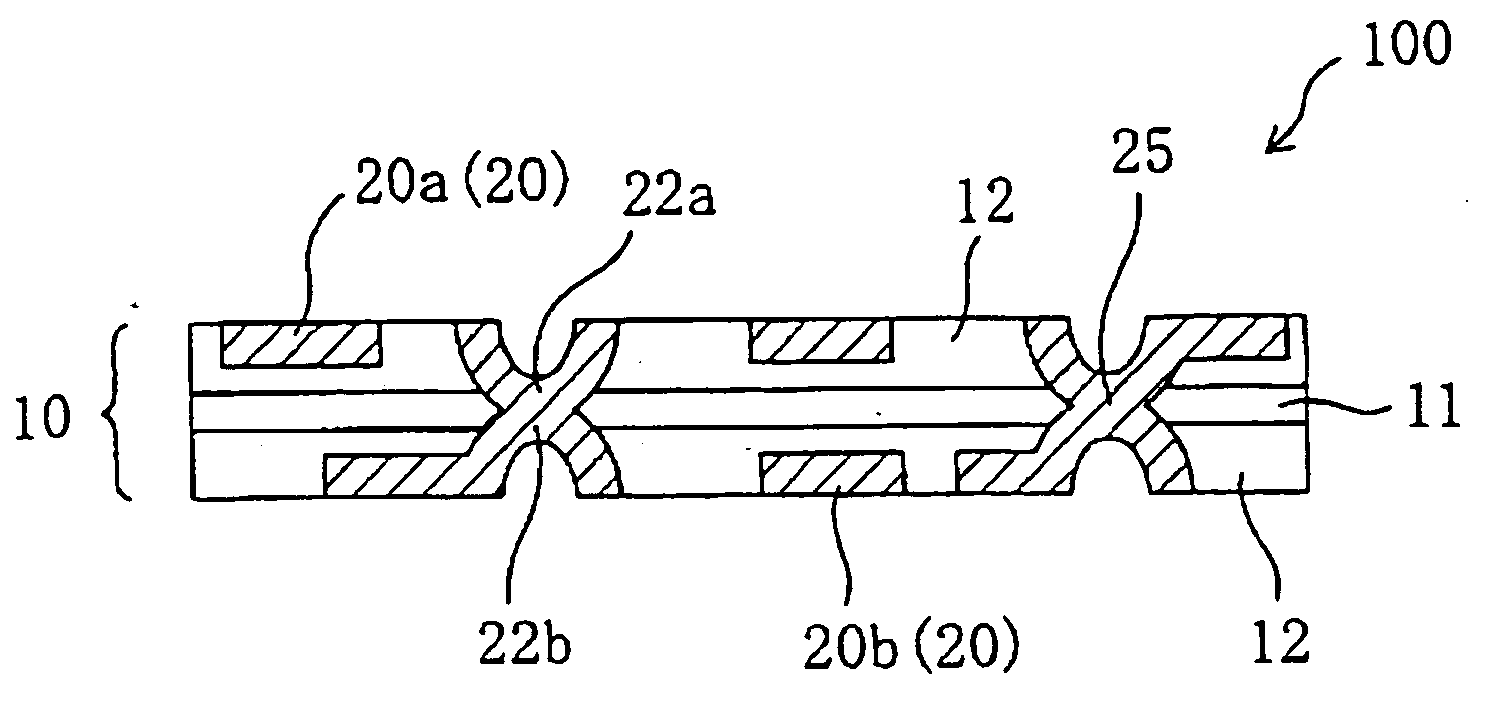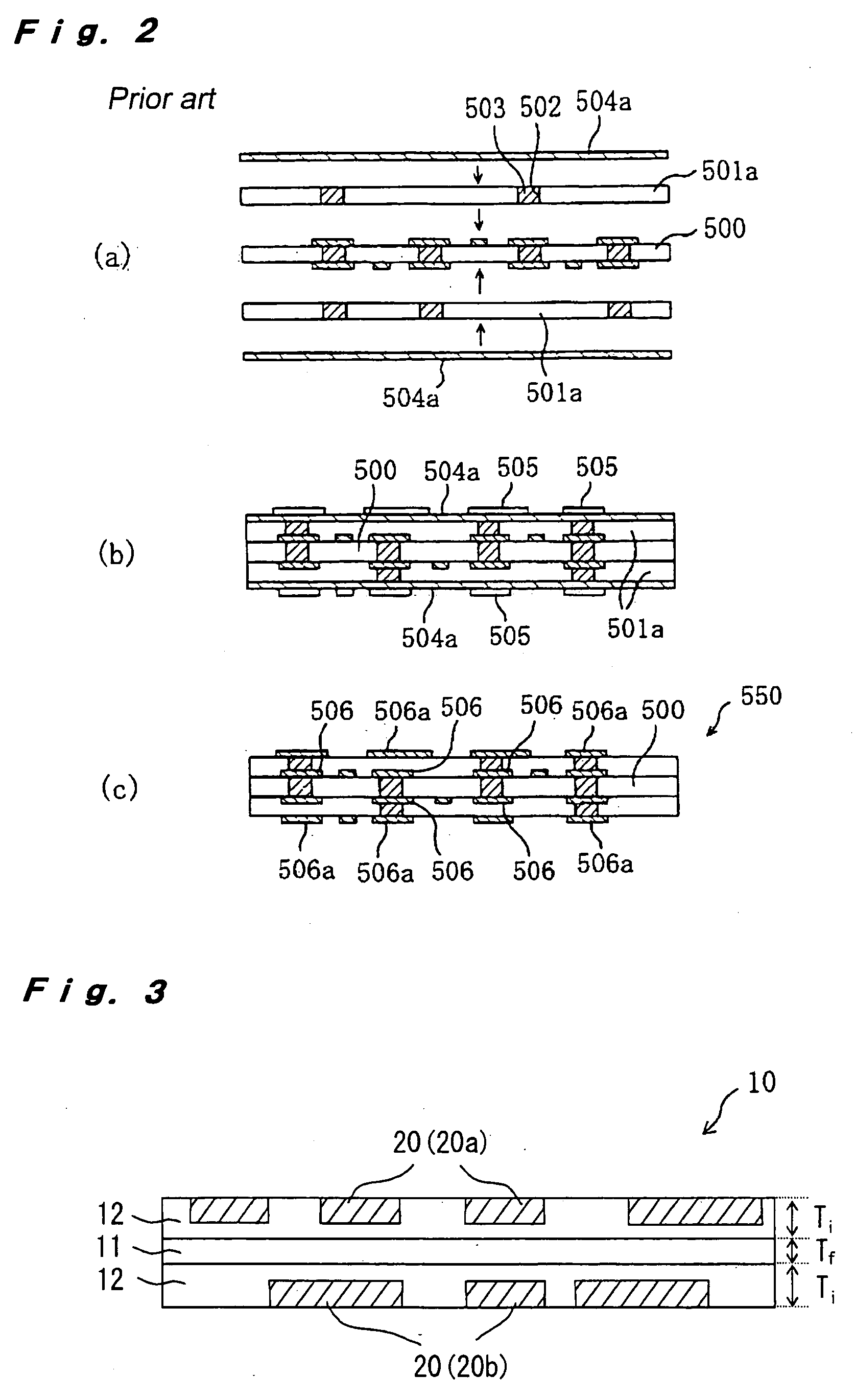Flexible substrate having interlaminar junctions, and process for producing the same
a technology of interlaminar junctions and flexible substrates, which is applied in the direction of conductive pattern formation, printed element electric connection formation, instruments, etc., can solve the problems of troublesome post-treatment washing and drying steps, micro cracks of wiring patterns, and far from satisfying in terms of flexing life, so as to prevent a discordance of impedance, improve the effect of producibility and easy holding of sheet members
- Summary
- Abstract
- Description
- Claims
- Application Information
AI Technical Summary
Benefits of technology
Problems solved by technology
Method used
Image
Examples
example 1
[0184] (Film Material)
[0185] A film (organic film) used in this example is shown in Table 1.
TABLE 1No.FILMNAME OF COMMODITY (MANUFACTURER)1aARAMID┌MICTRON┘(TORAY Co., Ltd.)1bARAMID┌ARAMICA┘(TEIJIN ADVANCED FILMCo., Ltd.)1cPI┌KAPTON┘(DU PONT-TORAY Co., Ltd.)1dPI┌UPILEX┘(UBE INDUSTRIES Co. Ltd.)1ePEN┌TEONEX┘(TEIJIN-DU PONT FILM Co. Ltd.)1fPET┌TETRON┘(TEIJIN-DU PONT FILM Co. Ltd.)1gPPS┌TORELINA┘(TORAY Co., Ltd)1hPA┌HARDEN┘(TOYOBO Co., Ltd)1iPC┌PANLITE┘(TEIJIN CHEMICALS Co., Ltd)1jPES┌SUMILITE FS-1300┘(SUMITOMO BAKELITECo., Ltd)1kPEI┌SUPERIO UT┘(MITSUBISHI PLASTICS, Inc.)1lPPE┌DIANIUM┘(MITSUBISHI PLASTICS, Inc.)1mPEEK┌SUMILITE FS-1100C┘(SUMITOMOBAKELITE Co., Ltd)
[0186] (Preparation of the Substrate Used for Measuring Flexing Life)
[0187] By applying an epoxy-base thermosetting resin layer to both surfaces of the film with a roll coater process, the insulating resin layers were formed. Subsequently, the wiring patterns were embedded into the insulating resin layers.
[0188] Prior to em...
example 2
[0195] (Preparation of the Substrate Used for Measuring Flexing Life)
[0196] In this example, by using of the method similar to the above example (1), various types of the sample substrates were prepared in such a manner that a ratio of insulating resin layer thickness / film, thickness is diversely changed. The specification of the prepared substrate is shown in the following Table 3.
TABLE 3MODULUS OFTHICKNESS(μm)ELASTICITY (GPa)INSULATINGINSULATINGINSULATINGRESIN LAYERORGANICWIRINGRESIN LAYER (ON ONERESINTHICKNESS / No.FILMPATTERNSURFACE OF FILM)FILMSUBSTRATELAYERFILMFILM THICKNESS2aARAMID3124280.8133.02bARAMID3116.528.50.8131.72cARAMID39.59280.8131.12dARAMID3812280.8130.72eARAMID3616280.8130.42fARAMID369210.8130.72gARAMID3129330.8131.3
[0197] (Test Condition)
[0198] All of the films used in this example were aramid film (“MICTRON” manufactured by TORAY Co., Ltd.) The sample substrates 2a to 2e were approximately same in thickness thereof, and the sample substrates 2c, 2f, and 2g wer...
example 3
[0201] In this example, the effect of the pressure-joint carried out in the production process of the present invention was confirmed. And also, the effect of the application of the ultrasonic wave to the interlaminar junctions was confirmed.
[0202] (Preparation of the Substrate Used for the Example (3))
[0203] As with the example (1), the film on both surfaces of which the insulating resin layers were formed was prepared, and also the two carrier sheets (i.e. copper foils that were respectively 70 μm in thickness) in which the wiring patterns were formed were prepared. The film used in the example (3) was aramid film (“MICTRON” manufactured by TORAY Co., Ltd.) having 4 μm in thickness. Each of insulating resin layers formed on both surfaces of the film was 10 μm in thickness. Each of the wiring patterns on the carrier sheets was formed by means of the electroplating technique in such a manner that the thickness of the wiring pattern was 9 μm. Subsequently, Each of carrier sheets on...
PUM
 Login to View More
Login to View More Abstract
Description
Claims
Application Information
 Login to View More
Login to View More - R&D
- Intellectual Property
- Life Sciences
- Materials
- Tech Scout
- Unparalleled Data Quality
- Higher Quality Content
- 60% Fewer Hallucinations
Browse by: Latest US Patents, China's latest patents, Technical Efficacy Thesaurus, Application Domain, Technology Topic, Popular Technical Reports.
© 2025 PatSnap. All rights reserved.Legal|Privacy policy|Modern Slavery Act Transparency Statement|Sitemap|About US| Contact US: help@patsnap.com



